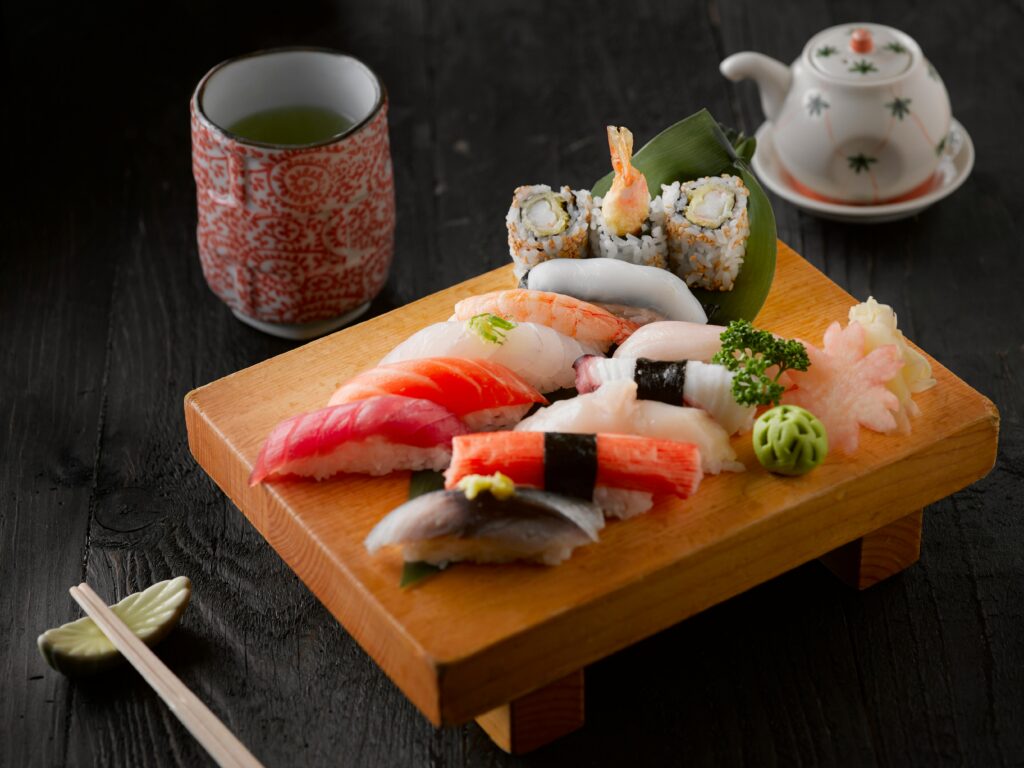When it comes to Japanese cuisine, we often find ourselves in a delicious dilemma: sushi, sashimi, nigiri, and maki. Each one has its own unique charm, from the simplicity of sashimi to the fun roll of maki. We might think we know what separates these tasty treats, but it’s easy to get them mixed up—especially after a couple of plates at the sushi bar!
Sushi is the umbrella term for various dishes that include vinegared rice, often topped with fish or vegetables. Meanwhile, sashimi is the star of the show when it comes to raw fish; it’s all about the fish, no rice necessary. Nigiri takes the best of both worlds, serving sushi rice with a slice of sashimi right on top. Oh, and let’s not forget maki—those delightful rolls that can turn a meal into a colorful party on our plates!
As we navigate the ocean of Japanese flavors, we can enjoy each dish for what it brings to our taste buds. Whether we’re digging into a slice of sashimi or picking up a soy-drenched maki roll, we’re bound to have a good time. So, let’s dive deeper into the world of sushi, sashimi, nigiri, and maki, and discover what makes each one special!
The Art of Sushi
When we think of sushi, we may get lost in thoughts of delicious fish and creativity. But sushi is a fine art that involves perfect ingredients and techniques. Let’s dive into the specifics of what makes sushi special.
Rice, Rice, Baby
First off, let’s talk about the star of our sushi experience: the rice. We use sushi rice, also known as vinegared rice, which is sticky and just the right texture. This enables us to form those perfect little mounds or rolls.
To make that delicious rice, we mix it with a splash of rice vinegar, sugar, and salt. This blend gives the rice a tangy kick that pairs perfectly with our fillings. We can’t forget the magic of the sushi chef’s hands, expertly working the rice into shape. It’s like sushi ballet!
Seaweed: It’s Not Just for Mermaids
Next, we can’t ignore the nori—the dark green seaweed that wraps around our sushi like a cozy blanket. Nori provides flavor and helps hold everything together. It’s not just decoration; it’s essential to our sushi’s structure.
Think of it as the invisible friend that makes our sushi roll possible. Plus, it’s rich in vitamins and adds a hint of umami, that elusive “fifth taste” we all crave. Nori can also play a starring role in temaki or hand rolls, allowing us to enjoy sushi in a fun, cone-shaped format.
Fish: The Star of the Show
Now, onto the main event—the fish! Whether it’s salmon, tuna, eel, or something more exotic like mackerel or sea bream, fish is the heart of our sushi feast. We can choose raw fish for that fresh, delicate flavor or cooked fish for a unique twist.
The key to great sushi is the freshness of the fish. Our taste buds ask for a fresh catch, perhaps even a bit of scallop or octopus. Exploring different types keeps our sushi adventures exciting. And for those of us who get a little squeamish about raw fish, fear not! The California roll has our back with its cooked fillings!
Roll It or Bowl It: Styles of Sushi
Finally, let’s explore the various ways to present our sushi. We can roll it up tightly into maki or simply pile it into a bowl for chirashi. Maki sushi is formed using nori and can be cut into delightful little pieces.
On the other hand, nigiri offers that beautiful hand-formed mound of rice topped with a succulent slice of fish. Each style has its charm. Whether we fancy the elegance of a well-rolled maki or the simplicity of nigiri, our choices are endless. When hunger strikes, we are ready to eat!
Sashimi and Nigiri: Delightfully Bare
When we think about the lovely world of Japanese cuisine, two dishes stand out for their simplicity and elegance: sashimi and nigiri. These dishes let the quality of the ingredients take center stage, offering us a delightful culinary experience without too much fuss.
Sashimi: A Slice of Heaven
Sashimi, our favorite raw fish feast, comes without the frills. It’s all about those thin slices of sashimi-grade salmon or other fish that dance on our palates. Whether we’re enjoying tuna, mackerel, or even octopus, each piece is a showcase of freshness.
We often pair it with a dab of wasabi for zing and a splash of soy sauce for that umami kick. And let’s not forget the sides! Pickled ginger helps cleanse our taste buds between bites, keeping our experience fresh and fun. We can even add daikon radish for that crunchy, refreshing bite.
Nigiri: The Hand-Pressed Delicacy
Now, let’s chat about nigiri, the cousin that’s a bit more dressed up. Nigiri starts with a hand-formed mound of sushi rice, perfectly seasoned with vinegar. Topped with raw fish or sometimes cooked sushi, it transforms into our charming little snack.
We love the artistry involved; each piece is a tiny masterpiece! Eating nigiri with chopsticks may take some skill, but it’s all part of our culinary adventure. The balance of textures, from the soft rice to the silky fish, makes each bite memorable.
And as we dip it in soy sauce, that mix of flavors truly elevates our taste buds. A sprinkle of shiso leaves adds another layer, making nigiri a delightful experience on every occasion.
The Maki Magic
Maki is a sushi style that turns each bite into a delightful adventure. It wraps our favorite ingredients inside a cozy seaweed blanket, making it the perfect handheld meal. Let’s unravel the magic behind two popular types of maki: hosomaki and futomaki.
Cut to the Chase: Hosomaki
First up, we have hosomaki. These delightful rolls are the petite versions of maki. Think of them as the sushi world’s bite-sized wonders.
Each hosomaki is made with vinegared rice and typically wrapped in nori. What makes them special is their filling. Common choices include fresh vegetables like cucumber or avocado, or even some raw or cooked fish.
The beauty of hosomaki lies in their simplicity. They are often made with just one filling, giving us a clean flavor with every bite. It’s sushi that feels like a hug from the ocean!
Size Isn’t Everything: Futomaki and Uramaki
Now, let’s talk about futomaki and uramaki, the bigger stars of the maki family. Futomaki is like the generous friend at a party, stuffed with multiple fillings. It can have fish, vegetables, or even fish roe for that added flair!
On the other hand, uramaki flips the script. The rice is on the outside, encasing the nori and fillings. This style often includes vibrant ingredients that shine bright, like colorful seafood and crispy vegetables.
Both styles are perfect for us when we want to share—or just enjoy a serious sushi feast. So grab your chopsticks and dive into these flavorful rolls!
Sides and Tidbits
When we order sushi, we don’t just stop at the main course. Our taste buds want a party! Let’s sprinkle in some sides and tidbits to jazz things up.
First up, soy sauce. It’s like the VIP sauce of our sushi party. A little dip can elevate our slices of sashimi and nigiri. Just don’t drown them like they’re doing a deep dive!
Next on the list is wasabi paste. A dollop of this green fire can wake us right up! A tip: a little goes a long way. We’d rather not blow our noses in public!
And let’s not forget pickled ginger. This pink gem is our mouth’s palate cleanser. It’s like a tiny, tangy refresh button that clears the way for more delicious bites.
We also love to sprinkle some green onion on our rice. It adds that perfect crunch and a fresh flavor. Speaking of crunch, let’s embrace the daikon radish! It’s our stealthy underdog, bringing texture without stealing the show.
Now, how do we elegantly maneuver all this goodness? With our trusty chopsticks, of course! They may take a bit of practice, but hey, we’re sushi ninjas now.
Lastly, we should keep our salt and sugar in check. Too much can ruin our sushi experience. Balance is key, just like the perfect mix of vinegar rice and fresh vegetables in rolls!
Frequently Asked Questions
We know sushi, sashimi, nigiri, and maki can spark some questions. Let’s dive into our playful curiosities about these tasty treats.
If Nemo were to dine out, would he pick maki or sashimi?
If our buddy Nemo had to choose, he’d likely go for maki! After all, those sushi rolls are more of a fish-friendly experience. Sashimi? Well, that feels a bit too much like an underwater buffet with no safety net for our little clownfish friend.
What’s the difference between a sushi roll and a yoga roll?
A sushi roll is a delightful culinary creation filled with rice, fish, and veggies. A yoga roll, on the other hand, is something you do to unwind, not to eat. So, let’s save the stretching for the mat and the eating for the plate!
Can you school me on the number of sushi types before my dinner date?
Absolutely! There are several types of sushi. We have nigiri, which is rice with a slice of fish on top, maki, which is sushi rolled with seaweed, and sashimi, which is just the fish. There’s also temaki, which is a hand roll. Consider yourself schooled!
Do I need a black belt to tell apart nigiri from sashimi?
No black belts required! Nigiri has rice topped with fish, while sashimi is just the fish solo on the plate. Think of nigiri as a buddy system and sashimi as your fish going solo for a more intimate dining experience.
Is it true that maki rolls can’t roll away because they’re not actually cooked?
That’s right! Maki rolls can’t roll away because they are not alive and kicking—they’re stuffed with delicious ingredients and rolled up tight. So no worries, they’re here to stay on our plates, ready for us to enjoy!
In the epic battle of sushi vs. sashimi, which one swims upstream?
In this culinary showdown, sushi and sashimi both have their strengths. Sushi offers the tasty blend of rice and fish while sashimi showcases the pure flavor of fish alone.


